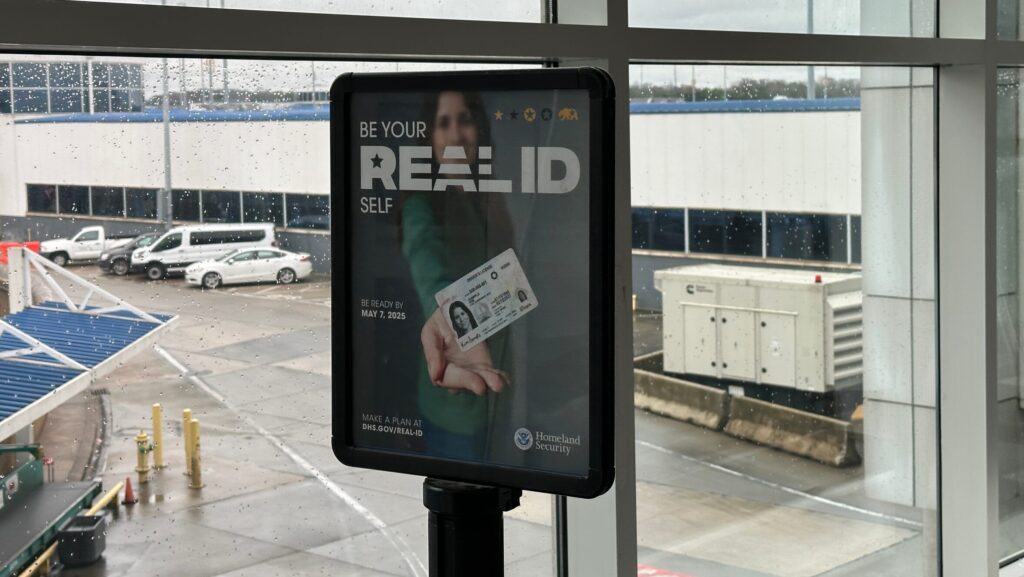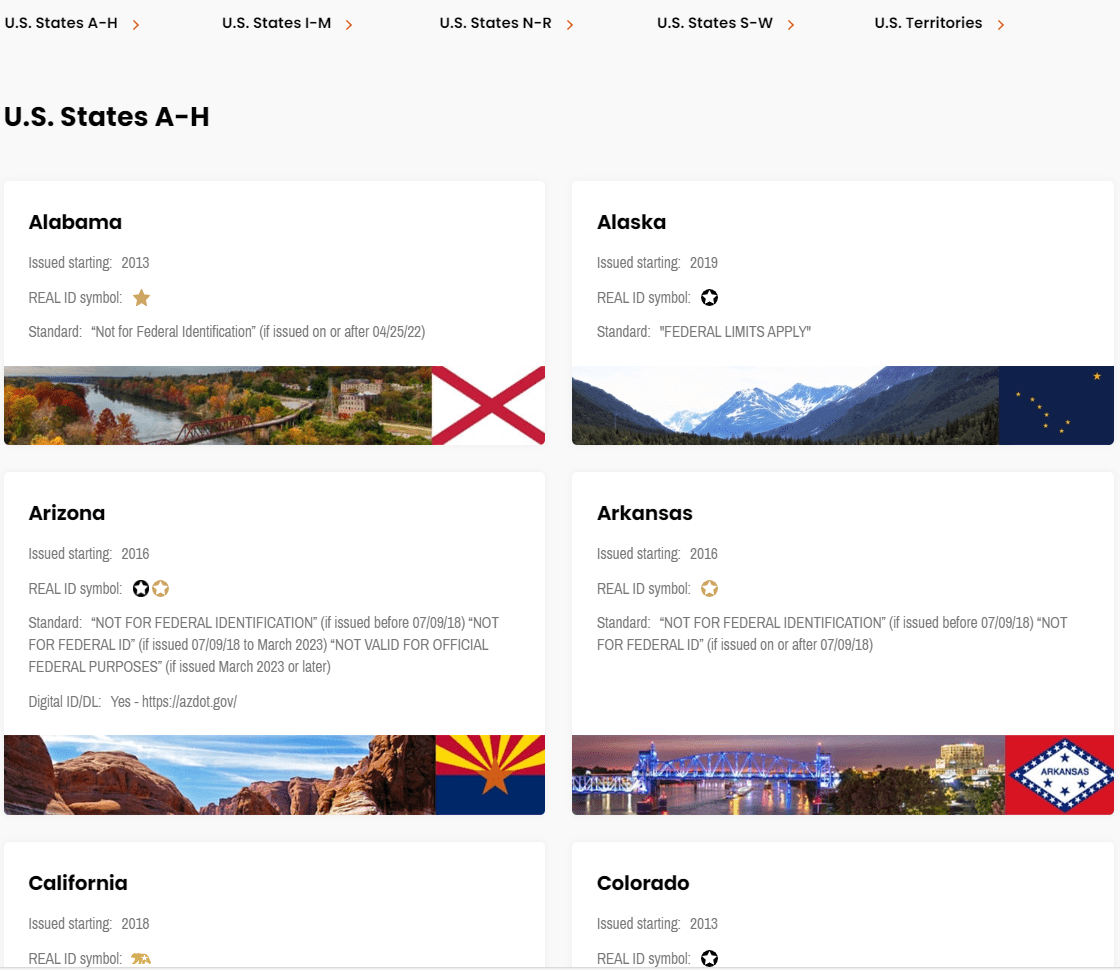Are You REAL ID Ready? [INFOGRAPHIC]
This year, changes are coming to ID requirements at checkpoints across the USA. The REAL ID Act will change the landscape of identification documents.
Starting May 7, 2025, a REAL ID-compliant license or another acceptable form of ID will be required for domestic flights or to access certain federal facilities. This new rule applies to all travelers aged 18 and over.
This article aims to provide a guide covering what it is, its requirements, and how to apply for one. We also included an exclusive infographic by Keesing Platform on the what the REAL ID journey has been like since 2018.
What is REAL ID?
The REAL ID Act was passed by Congress in 2005. It was a response to the 9/11 Commission’s recommendation to set security standards for driver’s licenses and identification cards issued by U.S. states and territories.
REAL ID-compliant cards are marked with a star symbol at the top. This star signifies that the ID meets federal security standards. The star design might vary depending on the state; in our free guide, we provide information on what the REAL ID symbol looks like for each state and territory, phrasing shown on standard (non-REAL ID credentials), and more. This guide is regularly updated.
The Act primarily affects how we travel domestically. After May 7, non-compliant ID cards will not be accepted at TSA checkpoints. This means you’ll need a REAL ID or another acceptable form of ID to fly within the United States. We have explained it below.
Why the Change?
This change will affect all U.S. citizens and residents who use identification for official purposes. It is rooted in security concerns. The 9/11 attacks exposed vulnerabilities in the U.S. identification system. In response to the 9/11 Commission’s recommendations, the Act sets federal standards for state-issued IDs. This ensures a uniform level of security across all states. It’s a significant step towards preventing identity fraud and terrorism.
Requirements to Obtain REAL ID
Obtaining a REAL ID requires certain documents. These documents are necessary to verify your identity and residency.
Firstly, you will need to provide proof of your identity. This could be a valid U.S. passport or a certified birth certificate. Other forms of identification may also be accepted.
To prove Social Security Number, a Social Security card or an IRS Form are accepted. It’s important to note that while the Act itself doesn’t require a Social Security number, some states do, so check with your local Department of Motor Vehicles (DMV).
You will also need to show proof of residency. Two documents showing your current address are needed. These could be utility bills, rental agreements, or mortgage statements.
Here is a summary of the requirements:
- Proof of identity (e.g., U.S. passport, birth certificate)
- Proof of Social Security number (e.g., Social Security card, W-2 form)
- Two proofs of residency (e.g., utility bill, rental agreement)
Remember, all documents must be originals or certified copies. Photocopies and digital versions are not accepted.
How to Apply
Applying is not a complex process, but it does require some preparation. Here’s a simple guide to help you.
First, gather all the necessary documents. As mentioned earlier, you’ll need proof of identity, Social Security number, and residency. Make sure all documents are original or certified copies.
Next, set up an appointment and visit your local Department of Motor Vehicles (DMV). Some states may allow you to start the application process online. However, you will still need to visit a DMV office in-person to finish the process.
At the DMV, you will submit your documents. You will also pay a fee. The fee varies by state, so check your local DMV’s website for details.
Here’s a summary of the application process:
- Gather necessary documents
- Visit local DMV
- Submit documents and pay fee
After applying, you will receive your REAL ID by mail. The delivery time varies by state. Check with your local DMV for an estimated delivery time.
The Enforcement Date for REAL ID Compliance
The enforcement date for compliance is fast approaching. It’s set for May 7, 2025. After this date, the old IDs will no longer be accepted at to board domestic flights and access certain federal facilities unless you have an acceptable alternative document. This rule applies to individuals aged 18 and older and it is recommended to start the application process as soon as possible.
Acceptable Alternatives to REAL ID
It’s important to note that the Act does not require individuals to show identification where it isn’t required, such as at certain federal facilities like the Smithsonian. The Act also allows institutions to accept other forms of identification. Before departing for the airport, travelers should consult the TSA for a comprehensive list of acceptable alternatives.
Here’s a list of some acceptable alternatives of identification documents:
- U.S. passport
- U.S. passport card
- DHS trusted traveler cards (Global Entry, NEXUS, SENTRI, FAST)
- U.S.-military ID (active duty or retired military and their dependents, and DoD civilians)
- Permanent resident card
- Border crossing card
- Enhanced Drivers Licenses (EDL) & Enhanced Identification Card (EID)
These are just a few examples. Check the official TSA website for a complete list.
TSA has ruled that U.S.-issued mobile driver’s licenses (mDLs) may be used for identity verification at airports and federal buildings, even after enforcement begins on May 7, 2025. Starting November 25, 2024, states can apply for temporary waivers to allow mDLs for identity checks, aligning with the guidelines.
According to U.S. DHS, “individuals should contact the agency they intend to visit to ask whether the agency accepts mDLs. To reduce risk of potential disruptions, TSA strongly encourages all mDL holders to carry their physical REAL ID cards in addition to their mDLs.”
Common Questions
Many people have questions about the REAL ID transition. These are some of the most common ones.
One question is, “Do I need a REAL ID to drive?” The answer is no. REAL ID is not required for driving across states. However, it is needed for domestic flying.
Another common question is, “Can I use my REAL ID to travel internationally?” The answer is also no. REAL ID is only for domestic flights. For international travel and crossing the border to Canada or Mexico, you’ll still need a passport.
Preparing for the Transition
Start by checking if your current ID is REAL ID-compliant. Look for a star at the top of the card. If it’s there, you’re all set. Some states also issue enhanced driver’s licenses that meet the standards and are marked with the word ‘Enhanced’ or display an American flag. If your ID is marked with ‘Not for Federal Purposes,’ it is not REAL ID-compliant.
If you don’t comply yet, gather the required documents for an application. This includes proof of identity, proof of Social Security number, and proof of residency. Finally, make an appointment at your local DMV to apply.
Stay Informed
You can stay informed about the latest updates by visiting Keesing’s REAL ID webpage and see the REAL ID status of every U.S. state and territory. We recommend you bookmark the page since it is constantly updated, such as when a state issue DLs in a new design and with a new REAL ID symbol.
If you are an organization, you can use resources like Keesing DocumentChecker to manually verify a REAL ID by checking its security features as well as document information and data positions. It also provides an MRZ check tool for quicker verification.
Having difficulty verifying the authenticity of IDs? Rely on our Expert Service Desk; customers with access to certified document experts and specialists can receive personalized guidance on detecting tampering and distinguishing between genuine and counterfeit IDs.
Feel free to contact us via sales@keesingtechnologies.com or +31(0)207157825 if you are interested in a free DocumentChecker demo account or if you have any other questions.
Sources
- U.S. Department of Homeland Security. (n.d.). REAL ID. Retrieved from https://www.dhs.gov/real-id
- Transportation Security Administration. (n.d.). REAL ID Frequently Asked Questions. Retrieved from https://www.tsa.gov/real-id
- https://www.[your-state-dmv-website].gov for REAL ID information in Your State.


